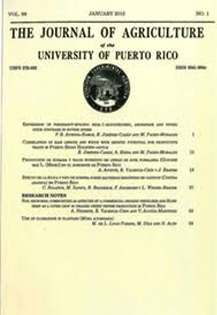Abstract
The response of inbred maize (Zea mays L.) lines to nitrogen (N) fertilizer and cowpea (Vigna unguiculata cv. Iron Clay) cover cropping was evaluated in three consecutive croppings from 2014 to 2016 in a Guamaní (Torrifluventic Haplustepts) soil. The crop rotation sequence was maize (spring 2014), cowpea (summer 2014), maize (winter 2014-2015), cowpea (summer 2015), maize (winter 2015-2016) and cowpea (summer 2016). The N fertilizer levels were 0, 90, 135, 180 and 225 kg N/ha for 2014 and 2014-2015 seasons, and 0, 50, 100, 150, and 200 kg N/ha for the 2015-2016 season. Soils were sampled to a depth of 90 cm before and after each successive cropping. Cover crop did not affect maize yields. The effect of N fertilizer on seed yield was observed in two out of the three years with optimum seed yields of 7,034 and 4,708 kg/ha with fertilizer N of 135 and 90 kg N/ha, respectively. Residual soil N tended to increase due to N fertilizer and cover crop. A partial aboveground N budget showed that the net N balance was more positive and increased with each successive fertilizer N level, reaching values of +516 kg N/ha in fallow and +621 kg N/ha with cover crop after three consecutive croppings over a 30-month period. Part of the excess N (not taken up by the crop) was accounted for in the soil profile. A slightly greater positive N balance at higher N fertilizer rates was due to the cover crop rotation. Cover-cropping with cowpea continues to be an important practice that in the long term will result in improved N recycling due to scavenging of residual soil N after maize cropping or by N fixation. Nitrogen fertilizer rates in the range of 90 to 135 kg N/ha can result in good inbred maize yields and can be adjusted with knowledge of soil inorganic N to a depth of 30 cm, that will result in higher yields, improved N use efficiency and reduced losses to the environment.

